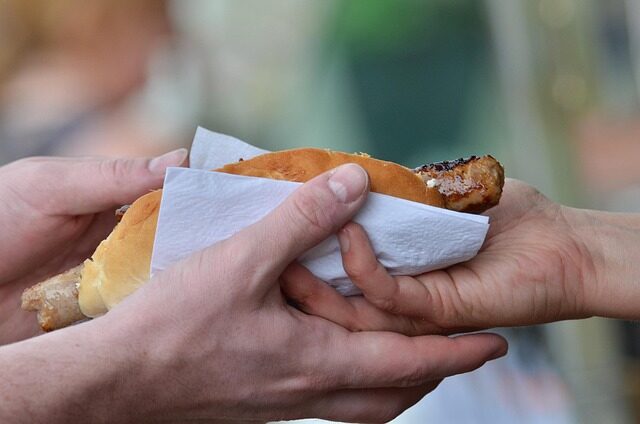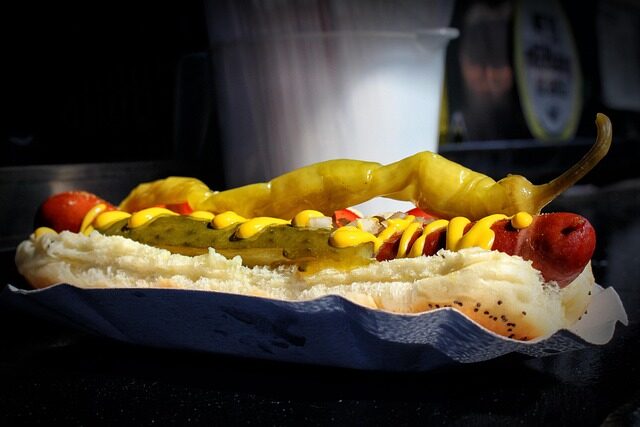Delving into the heart of Norwegian culinary tradition, the Norwegian hotdog, or pølse, emerges as a beloved national snack that transcends mere fast food status. It’s a dish steeped in heritage, evoking memories of community and celebration, wrapped in a humble bun or a lompe, a traditional potato flatbread. Here, we explore the pølse’s journey from medieval roots to its place as a cornerstone of Norwegian culture and cuisine.
With each bite of a pølse, Norwegians taste a piece of their history. A taste of tradition that carries the essence of Norway, this simple yet versatile creation can be found at sporting events, family gatherings, and notably, during the festivities of National Day, where it symbolizes national pride as much as it satisfies collective appetites.
- How did the Norwegian hotdog become a national favorite?
- What makes the pølse unique in Norwegian cuisine?
- Where can you enjoy authentic Norwegian hotdogs?
- What are the different varieties of Norwegian pølser?
- What toppings complement the Norwegian hotdog?
- How do Norwegian hotdogs compare to other Scandinavian hotdogs?
- What is the history behind the pølse in Norway?
- How did the Norwegian hotdog become a national favorite?
- What makes the pølse unique in Norwegian cuisine?
- Where can you enjoy authentic Norwegian hotdogs?
- What are the different varieties of Norwegian pølser?
- What toppings complement the Norwegian hotdog?
- How do Norwegian hotdogs compare to other Scandinavian hotdogs?
- What is the history behind the pølse in Norway?
How did the Norwegian hotdog become a national favorite?
Post-World War II Norway welcomed the pølse with open arms, embracing an American fast food influence that soon became a local custom. The transition of the Norwegian hotdog from an exotic novelty to a national favorite is a tale of culinary adaptation, where a foreign concept was skillfully integrated into local food culture, becoming an indispensable part of social events and daily life.
It’s not just about accessibility; the pølse’s popularity lies in its ability to evoke nostalgia. For many Norwegians, the aroma of a grilled hotdog brings back cherished memories of youth and celebration, contributing to its emblematic status.
Moreover, the Norwegian pølse’s prominence is underscored on National Day, when an estimated 13 million hotdogs are consumed—a testament to its unifying role in Norway’s society.
Indeed, as an emblem of Norwegian street food, the hotdog stands tall, revealing the nation’s appetite for tradition that is easily shared and enjoyed by all, regardless of age or background.
Yet, the pølse is not just a fast food item; it’s a culinary canvas, allowing for a variety of interpretations that range from simple to gourmet, each reflecting the diverse palette of Norwegian taste.

What makes the pølse unique in Norwegian cuisine?
Norwegian cuisine is often characterized by its use of fresh, local ingredients, and the pølse is no exception. The distinctiveness of the Norwegian hotdog lies in its regional variations; each recipe tells a story of the area it hails from, whether it’s the spicy kick of a pølse from the north or the savory notes of one made in the south.
The pølse, often served in a lompe or a hearty bun, is not merely a sausage; it is a reflection of Norway’s culinary identity. The use of high-quality meats and a careful balance of spices contribute to the pølse’s standout flavor profile that is markedly Norwegian.
The versatility of the pølse also adds to its uniqueness. From the grillpølse, perfect for barbecues, to the baconpølse, a treat for the senses, there is a pølse for every palate and occasion.
Aside from the traditional grilled or boiled serving methods, innovative Norwegian chefs have taken the humble hotdog to new heights, creating gourmet versions that challenge the boundaries of street food.
The result is a culinary identity that proudly places the pølse at the forefront, not just as a quick bite, but as a gastronomic experience that honors its history while embracing innovation.
Where can you enjoy authentic Norwegian hotdogs?
From bustling city streets to serene coastal towns, the pølse is ubiquitous across Norway. The best places to buy pølser in Norway range from quaint stands by the fjords to the dynamic hotdog kiosks of Oslo.
Convenience stores in Norway are also proud purveyors of the pølse, ensuring that this culinary delight is readily available to satisfy any spur-of-the-moment cravings.

For the traveler seeking an authentic taste, visiting a local market or festival offers a chance to not only enjoy a fresh pølse but also to engage with the vibrant community life that it symbolizes.
And for those looking to indulge in the gourmet side of the pølse, an array of specialized restaurants presents creative takes on the classic, pairing it with artisanal bread and exotic toppings.
Each location offers a different ambiance, but the common thread is the pride with which Norwegians serve up their cherished hotdogs—a pride that is palpable in every savory bite.
What are the different varieties of Norwegian pølser?
Norway’s pølse landscape is as diverse as its geography, with each variety reflecting the unique tastes and traditions of its region. From the hearty bratwurst-inspired styles to the delicate wienerpølse, the sausage varieties in Norway are a testament to the pølse’s adaptability.
Some of the most popular varieties include:
- Grillpølse: A thicker sausage, perfect for grilling and a favorite at barbecues.
- Lammepølse: Made with lamb, this pølse carries a distinctive flavor beloved in the countryside.
- Reinsdyrpølse: Featuring reindeer meat, it provides a gamey twist that’s popular in the northern regions.
- Veggie pølse: Catering to the growing demand for plant-based options, this variety ensures that everyone can partake in the pølse tradition.
These are just a few examples of the myriad pølse types that populate Norwegian menus, each offering a unique gustatory journey.
Moreover, the rising popularity of gourmet hotdogs has introduced even more specialized varieties, incorporating ingredients like truffles, blue cheese, and organic meats, thereby expanding the pølse’s horizons further.

The diversity of pølse types speaks to the innovation and creativity inherent in Norwegian cuisine, showcasing a willingness to experiment while staying true to the hotdog’s traditional roots.
What toppings complement the Norwegian hotdog?
While the sausage itself is crucial, it’s the toppings that truly complete the pølse experience. A plethora of options allows for personalization, turning each hotdog into a unique creation.
Traditional toppings typically include:
- Mustard: From sweet to spicy, mustard is a staple that adds a zesty kick.
- Ketchup: A classic choice, offering a hint of sweetness to balance the savory sausage.
- Roasted onions: Adding crunch and depth of flavor, they’re a favorite among locals.
- Mayonnaise: Often used in moderation to add creaminess and complement other toppings.
- Pickled cucumbers: Providing a tangy contrast that cuts through the richness of the meat.
In addition to these traditional options, Norwegian hotdog aficionados often experiment with more unconventional toppings like shrimp salad, crispy bacon, or lingonberry sauce, each lending a unique flair to the Norwegian hotdog.
The beauty of the pølse is that there is no right or wrong way to top it. Whether you prefer a simple smear of mustard or an elaborate array of garnishes, the pølse invites you to make it your own.
How do Norwegian hotdogs compare to other Scandinavian hotdogs?
The rivalry among Scandinavian countries extends to their hotdogs, with each nation boasting its own version of this popular street food. Yet, the Norwegian pølse stands out for its variety and the way it is woven into the fabric of the country’s cultural identity.
Compared to its Swedish counterpart, the Norwegian pølse often features a wider array of meat choices and is typically served in a lompe rather than a traditional bun.

In Denmark, the hotdog is usually accompanied by remoulade and pickled cucumbers, offering a different taste profile compared to Norway’s simpler yet hearty approach.
The Finnish version often includes a unique rye bread, highlighting the regional bread-making traditions of Scandinavia.
Despite these differences, what unites these versions is a shared appreciation for quality ingredients, a love for culinary tradition, and the comfort that comes with enjoying a delicious hotdog in good company.
What is the history behind the pølse in Norway?
The pølse’s storied history in Norway is as rich and varied as the sausage itself. Dating back to the Middle Ages, the practice of sausage-making was a means of preserving meat. Over time, it evolved, and the modern pølse, as we know it, began to take shape in the post-war era, influenced by the rise of American fast food culture.
As the Norwegian hotdog gained popularity, it became more than just a quick meal; it became symbolic of post-war recovery and prosperity.
The pølse’s significance is further magnified on National Day, where it is consumed in staggering numbers, illustrating its role as a national symbol of celebration and unity.
The hotdog’s evolution from a simple street food to a gourmet item also mirrors Norway’s own growth and diversification in culinary tastes and preferences.

As we gaze upon the rich tapestry that is the history of the pølse, we see not just a food item but a cultural artifact that continues to shape and reflect the Norwegian way of life.
To get a visual taste of the Norwegian hotdog, let’s take a moment to watch an informative and visually appealing video that delves into the world of the pølse in its native land.
In conclusion, the pølse is more than just a tasty treat; it’s a reflection of Norwegian culture, history, and pride. From its humble beginnings to its modern-day gourmet iterations, the Norwegian hotdog remains a cherished culinary icon, savored by locals and visitors alike. As you bite into a pølse, you’re not just enjoying a meal—you’re partaking in a tradition that is quintessentially Norwegian.

